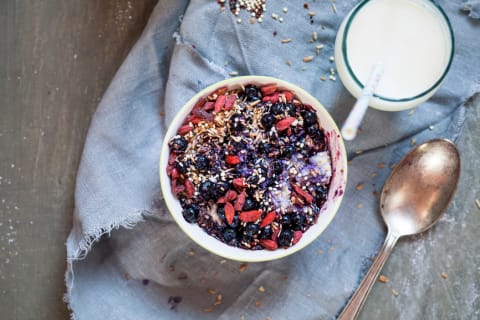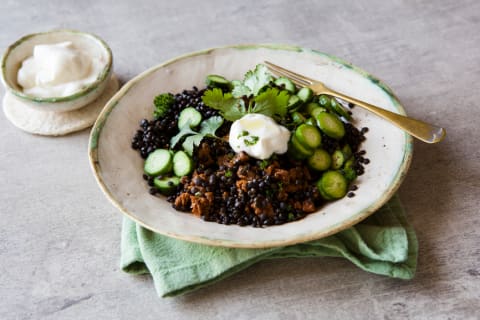Advertisement
The One-Day Thyroid Diet This Hormone Doctor Swears By


Five years ago, I said goodbye to my husband, daughters, and cozy Berkeley home like I did every day and headed to the lab for a simple blood test. Afterward, I was never the same.
Why? Because I found out my body was in a failure state, as measured by my telomeres, the protective caps on chromosomes that reflect how fast you are aging. As with many stories of initiation, my failing telomeres started me on an unplanned journey of surrender and healing.
I began poring over 2,500 studies in order to design a protocol that resets the process of aging. I was already a busy mom and board-certified physician practicing functional medicine, but I became an expert at eating in ways that slow down the clock.
I discovered that only 10 percent of your risk of disease is genetic; 90 percent is environmental—mostly your daily lifestyle choices and the biochemical neighborhood those choices create for your DNA.
I gain weight way too easily—diabetes and obesity run in my family, along with poor stress resilience—so I've learned that I need to be strategic with my food plan. I eat foods that stabilize my blood sugar and don't cause high cortisol, meaning I eat lots of fiber, no gluten, and no dairy. Meticulous eating improves my healthspan, the period of my life during which I feel in my prime, free from disease, in hormonal harmony, and looking and feeling young. I've learned how to eat appropriately for my body in accordance with my genetic tendencies in order to actually slow down the pace of my body's aging. This is the whole idea behind my new book, Younger: A Breakthrough Program to Reset Your Genes, Reverse Aging, and Turn Back the Clock by 10 Years.
Currently my diet is about 98 percent plant-based. I enjoy the occasional pastured red meat, especially when I'm menstruating and crave the iron, but I do much better and my weight is easier to handle as a flexitarian pescatarian.
In short, these are the principles I live by:
- I aim for 20 to 30 different plant species each week. When I travel, I try to eat local. As I write this article, I'm in Hawaii looking forward to my sea asparagus salad with Maui onion.
- I avoid processed food. My concept of "processed" has changed over time. Now I think of processed foods as anything packaged, boxed, jarred, or labeled with more than one ingredient. These days, I eat a salad with avocado instead of processed salad dressing. I only eat health bars in an emergency, not as a meal replacement on the go. I eat chickpeas, not store-bought hummus.
Fiber is the key to clearing out excess estrogen and stabilizing insulin.
- On average, blood sugar rises 10 points (in mg/dL) by age 50. I aim for about 40 to 50 grams of fiber per day, but you have to slowly build up to this high level without gas and discomfort.
- Unfortunately about 90 percent of fresh produce has been treated in some way, often with environmental toxins like Persistent Organic Pollutants (POPs). Too many of the wrong calories combined with a body burden of toxins leads to obesity, diabetes, and shorter healthspan.
- I choose a diverse range of foods and drinks that are high in nutrient density, so that my gut microbes are happy. I follow the basic functional medicine law that food is information for your DNA and also the DNA of your microbes.
- Eating most of the colors of the rainbow each day helps to fill my micronutrient gaps.
- I follow my food code—my personal code for eating congruent with my values and bodily needs, while honoring the fact that I'm a recovering food addict who always wants more. Eating for healthspan and hormone balance is now second nature to me.
- When I eat meat, I make sure it is anti-inflammatory. I usually choose elk, bison, or rabbit.
- I consume low-mercury, wild-caught fish twice per week and take a supplement because it keeps my fatty acids in balance. I have a gene called PPARG that keeps my weight down if I eat more fish than meat, so my menus feature a lot of salmon, halibut, cod, and steelhead trout.
- Note that the following food plan is designed for weight loss. If you're at your goal weight, I suggest adding more fat (avocado, olives, macadamia nuts, other nuts, cold-pressed oils), starchy vegetables, or tubers (carrots, winter squash, beets, sweet potatoes, yucca), and/or gluten-free grain, if you don't have autoimmune problems or intolerances.
Most of all, I eat portions that are right for my body, because I'm a recovering food addict who gains weight if I eat unmeasured food. In the spirit of transparency, I've included the measurements of all of my food.
Here's a typical day on my food plan.
My day begins at 6 a.m. and ends at 10 p.m. I sleep in a completely dark room at 64 degrees Fahrenheit (reduces night sweats) and usually wake up without an alarm.
For the past three months, I start my day with a steamy mug of matcha tea. I whip it with a handheld frother and then add a fresh squeeze of Meyer lemon. I encourage my patients to replace their coffee with tea to decrease their intake of caffeine, which can make you feel stressed and disrupt your sleep if you're like me and have the slow CYP1A2 gene variant, meaning you metabolize caffeine slowly. (The CYP1A2 gene is responsible for metabolizing 95 percent of caffeine and can also be a marker for how you metabolize stress.)
Supplements
While my water is heating, I drink a full glass of filtered water and take my supplements. Right now that includes:
- For thyroid support: 1 grain of WP Thyroid, which has no fillers. It contains natural desiccated thyroid, inulin from chicory root, and medium-chain triglycerides.
- For estrogen support: diindolylmethane
- For blood sugar support: berberine with milk thistle, which helps it work better, plus fish oil. To balance my fish oil, I take gamma-linoleic acid, which strengthens my skin, hair, and nails.
- For antioxidant support: alpha lipoic acid and resveratrol
- Liver support and to remove toxins: I take N-acetyl cysteine
Breakfast

I eat around 7 a.m. with my husband and daughters. I take three deep breaths before I eat because my old habit was to shovel in breakfast while speed-reading the newspaper. I have to actively and consciously slow down before my meals in order to create new neural pathways.
Here's the menu (all organic):
- 3 ounces quinoa, which I cook once or twice per week in a rice cooker. I place the cooked quinoa in a huge bowl. Then I add:
- 3 tablespoon freshly ground flax, and a little sea salt (my blood pressure tends to be low, and I need sea salt to help support my adrenal glands)
- 6 ounces frozen blueberries or other seasonal fruit
Finally, I drink half a serving of a fresh green smoothie. I have a number of food intolerances so I prefer to use pea protein in my smoothie. Today I made the following recipe, a favorite especially on a cold or rainy morning:
- 1 scoop chocolate protein powder
- 1 teaspoon organic spirulina
- 5 to 8 ice cubes
- optional: 1 tablespoon MCT oil
Lunch

At 12:30 p.m., I assemble lunch. It's the same basic framework each day: 4 ounces of protein, 6 ounces of cooked vegetables, and 6 ounces of a salad, including fermented vegetables, usually all leftovers from the day before. Here's today's menu:
- 4 ounces lentils
- 6 ounces nonstarchy vegetables, like zucchini and broccolini
- Salad: 6 ounces of chopped cucumber, sugar-plum grape tomatoes, and mixed fermented vegetables (green cabbage, turmeric, ginger, garlic), topped with 1 tablespoon MCT oil and a generous squeeze of Meyer lemon
Dinner

We eat a family dinner around 6:30 p.m. Here's today's selection:
- 4 ounces wild-caught Steelhead trout
- 4 ounces Spigariello raab
- 2 ounces fermented vegetables (tonight was turnips, red beets, red onion, juniper)
- 6 ounces salad with 2 ounces avocado
I have no choice but to listen to my telomeres. In aggregate, my protocol offers me longer telomeres and healthspan and helps me fit into my skinny jeans. Specifically, I retested my telomeres last fall and found that I closed the age gap by 17 years: At age 49, I had the telomeres of a 52-year-old woman. Then I tested my protocol on 1,000 people and they added, on average, 10 years to their healthspan.
As I describe in my new book, sometimes the path of true healing moves you in surprising yet purposeful ways. If you don't eat this way, consider trying my food plan for a few days and see how you feel.
In the coming year, I've set my sights on helping people extend their healthspan—starting with their DNA and how it guides your body toward fast or slow aging. Ultimately, I want to change the conversation we're having about aging. But I need your help.

Sara Szal Gottfried MD is a physician, researcher, author, and educator. She graduated from Harvard Medical School and MIT, and completed residency at UCSF, but is more likely to prescribe a continuous glucose monitor and personalized nutrition plan than the latest pharmaceutical. Dr. Gottfried is a global keynote speaker and the author of four New York Times bestselling books about hormones, nutrition, and health. Her latest book is called The Autoimmune Cure (March 2024). She is Clinical Assistant Professor in Dept. of Integrative Medicine and Nutritional Sciences at Thomas Jefferson University, and Director of Precision Medicine at the Marcus Institute of Integrative Health. Her focus is at the interface of mental and physical health, N-of-1 trial design, personalized molecular profiling, use of wearables, and how to leverage these tools to improve health outcomes. Learn more at SaraGottfriedMD.com
More from the author:
How To Balance Your Hormones
Check out Correct Hormone Imbalance For Better Skin, Improved Digestion & Less Fatigue
More from the author:
How To Balance Your Hormones
Check out Correct Hormone Imbalance For Better Skin, Improved Digestion & Less Fatigue

Sara Szal Gottfried MD is a physician, researcher, author, and educator. She graduated from Harvard Medical School and MIT, and completed residency at UCSF, but is more likely to prescribe a continuous glucose monitor and personalized nutrition plan than the latest pharmaceutical. Dr. Gottfried is a global keynote speaker and the author of four New York Times bestselling books about hormones, nutrition, and health. Her latest book is called The Autoimmune Cure (March 2024). She is Clinical Assistant Professor in Dept. of Integrative Medicine and Nutritional Sciences at Thomas Jefferson University, and Director of Precision Medicine at the Marcus Institute of Integrative Health. Her focus is at the interface of mental and physical health, N-of-1 trial design, personalized molecular profiling, use of wearables, and how to leverage these tools to improve health outcomes. Learn more at SaraGottfriedMD.com
Watch Next
Enjoy some of our favorite clips from classes
Enjoy some of our favorite clips from classes
What Is Meditation?
Mindfulness/Spirituality | Light Watkins
Box Breathing
Mindfulness/Spirituality | Gwen Dittmar
What Breathwork Can Address
Mindfulness/Spirituality | Gwen Dittmar
The 8 Limbs of Yoga - What is Asana?
Yoga | Caley Alyssa
Two Standing Postures to Open Up Tight Hips
Yoga | Caley Alyssa
How Plants Can Optimize Athletic Performance
Nutrition | Rich Roll
What to Eat Before a Workout
Nutrition | Rich Roll
How Ayurveda Helps Us Navigate Modern Life
Nutrition | Sahara Rose
Messages About Love & Relationships
Love & Relationships | Esther Perel
Love Languages
Love & Relationships | Esther Perel
What Is Meditation?
Box Breathing
What Breathwork Can Address
The 8 Limbs of Yoga - What is Asana?
Two Standing Postures to Open Up Tight Hips
How Plants Can Optimize Athletic Performance
What to Eat Before a Workout
How Ayurveda Helps Us Navigate Modern Life
Messages About Love & Relationships
Love Languages
Advertisement

What Men Are Getting Wrong About Mental Health, From A Psychologist
Stephen B. Poulter, PhD

Your Grandma's Go-To Supplement Is Once Again Popular (For A Good Reason)
Molly Knudsen, M.S., RDN

What Men Are Getting Wrong About Mental Health, From A Psychologist
Stephen B. Poulter, PhD

Your Grandma's Go-To Supplement Is Once Again Popular (For A Good Reason)
Molly Knudsen, M.S., RDN













